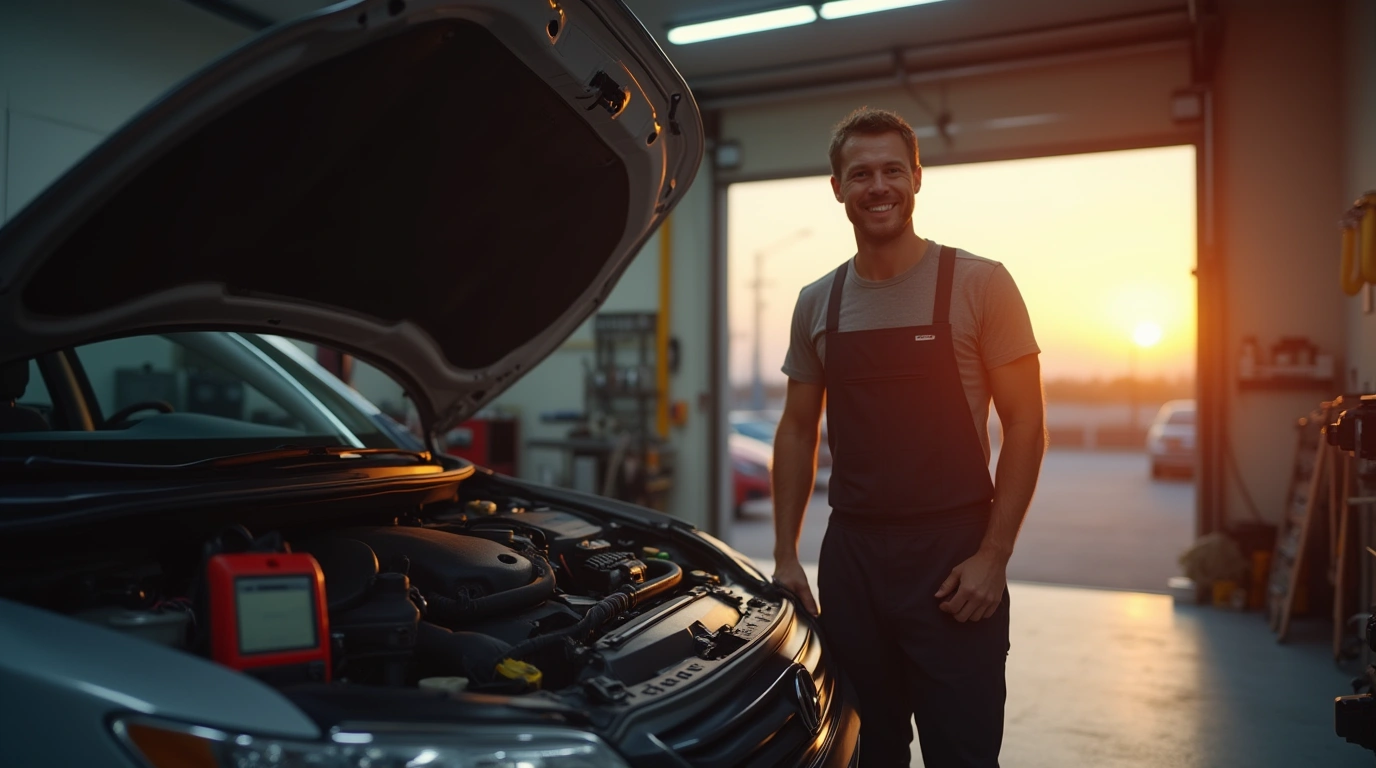Imagine this: you’re cruising down the road, music blasting, when suddenly your dashboard lights up like a Christmas tree. That sinking feeling hits—panic, frustration, and the dread of a hefty repair bill. I’ve been there, stranded with a sputtering engine, wishing I’d known what was wrong before the tow truck arrived. Cars can feel like temperamental beasts, but here’s the truth: you don’t need to be a mechanic to figure them out. Auto diagnostics can be your superpower, putting you back in the driver’s seat—literally and figuratively. In this article, you’ll learn how to troubleshoot your car like a pro, saving time, money, and a whole lot of stress. Ready to take control under the hood? Let’s dive in.

Why Auto Diagnostics Matter for You
Let’s get real—your car’s a lifeline. It gets you to work, hauls your groceries, and takes you on those weekend escapes. So when it starts acting up, it’s more than an inconvenience; it’s personal. That’s where auto diagnostics come in. By spotting problems early, you can dodge breakdowns before they leave you stranded. Think about it: a simple check could catch a dying battery or a loose sensor, saving you from a roadside nightmare.
And the money? Oh, you’ll love this part. According to AAA, about 20% of breakdowns tie back to battery issues—something you could catch with a $20 tool instead of paying a mechanic $100+ to diagnose. Learning auto diagnostics isn’t just practical; it’s empowering. You’re not helpless anymore—you’re the one calling the shots. Ready to see how easy it can be? Let’s gear up.
Essential Tools for Auto Diagnostics
You don’t need a garage full of gadgets to start troubleshooting. A few key tools can turn you into a car-whisperer, and they’re more affordable than you might think. Here’s your must-have toolkit:
| Tool | Purpose | Approx. Cost |
|---|---|---|
| OBD-II Scanner | Reads error codes from your car’s computer | $20-$50 |
| Multimeter | Tests battery and electrical systems | $15-$30 |
| Flashlight | Spots leaks or wear in tight spots | $5-$10 |
| Screwdriver Set | Opens panels for basic checks | $10-$20 |
- OBD-II Scanner: Plugs into your car (usually under the dashboard) and spits out codes telling you what’s wrong. It’s like a translator for your vehicle’s brain.
- Multimeter: Checks if your battery’s holding a charge or if wires are fritzing out—simple and foolproof.
- Flashlight: Lets you peek under the hood or chassis for leaks or damage.
- Screwdriver Set: Helps you pop off covers to inspect belts or fuses.
You can grab these at AutoZone, Amazon, or even Walmart—total cost under $100. With these in hand, you’re ready to tackle most basic auto diagnostics like a seasoned pro.
Step-by-Step Guide to Auto Diagnostics

Now, let’s get to the fun part—figuring out what’s up with your car. Don’t worry; you don’t need a degree in engineering. Follow these five steps, and you’ll be diagnosing like a champ:
- Check Your Dashboard Lights: Those glowing icons aren’t just decoration. A check engine light could mean anything from a loose gas cap to a misfiring engine. Note what’s on—your first clue.
- Plug in an OBD-II Scanner: Hook it up, turn your key to “on” (engine off), and let it scan. It’ll spit out codes like P0300 or P0420. Jot them down—you’ll decode them soon.
- Inspect Fluids and Battery: Pop the hood. Check oil (dark and gritty?), coolant (low?), and brake fluid. Use your multimeter on the battery—12.6 volts is healthy; below 12.2 means trouble.
- Listen for Odd Noises: Start the engine. Hear a rattle, whine, or clunk? A grinding brake might point to pads; a hiss could be a vacuum leak. Your ears are your allies.
- Test Drive and Observe: Take a short spin. Does it hesitate, pull, or smell funny (like burning rubber)? These are symptoms you can match to issues.
This process, straight from Haynes repair manuals, is your roadmap. Each step builds on the last, giving you a clear picture of what’s wrong. You’ve got this—let’s decode those clues next.
Common Auto Diagnostics Codes and Fixes
Those OBD-II codes? They’re your car’s way of talking. Here’s a rundown of common ones you might see, plus fixes you can handle:
| Code | Issue | DIY Fix |
|---|---|---|
| P0300 | Random Cylinder Misfire | Check spark plugs ($5-$10 each) |
| P0420 | Catalytic Converter Issue | Inspect O2 sensors ($20-$50) |
| P0171 | System Too Lean | Clean MAF sensor ($10 cleaner) |
| P0440 | Evap System Leak | Tighten/replace gas cap ($5-$15) |
- P0300: Your engine’s stumbling—swap out worn spark plugs or a faulty coil.
- P0420: Converter trouble often ties to a bad oxygen sensor; replace it before assuming the worst.
- P0171: Too much air, not enough fuel—clean your mass airflow sensor with a quick spray.
- P0440: A small leak, often just a loose cap; tighten it or grab a new one.
These fixes, sourced from OBD-II databases, can save you hundreds. Decoding the mystery yourself feels like cracking a code—and you’re the hero who does it.
When to Call a Pro After Auto Diagnostics
You’re rocking this, but some jobs need a pro’s touch. Here’s when to wave the white flag:
- Complex Engine Issues: Codes like P0300 might point to deeper problems (e.g., timing belt) you can’t tackle without a lift.
- Transmission Woes: Slipping gears or odd shifts mean it’s time for expert tools.
- Safety Risks: Brake or steering faults? Don’t chance it—get to a shop.
Automotive forums agree: DIY auto diagnostics shine for small fixes, but pros handle the big stuff. You’ll know when to tap out—and that’s part of being a smart troubleshooter.
Conclusion: Master Your Car with Confidence
Auto diagnostics don’t have to intimidate you—they’re your ticket to understanding your car and keeping it running smoothly. With a few tools, some basic steps, and a little curiosity, you can troubleshoot like a pro, dodging breakdowns and mechanic markups. Try it next time your check engine light blinks—you’ll be amazed at what you can handle. Got a car story or a fix you nailed? Share it below—I’d love to hear how you’re taking charge!
Outline
H1: Auto Diagnostics Made Simple: Troubleshoot Your Car Like a Pro
Opening: Emotionally Resonant Introduction
Imagine this: you’re cruising down the road, music blasting, when suddenly your dashboard lights up like a Christmas tree. That sinking feeling hits—panic, frustration, and the dread of a hefty repair bill. I’ve been there, stranded with a sputtering engine, wishing I’d known what was wrong before the tow truck arrived. But here’s the good news: auto diagnostics don’t have to be a mystery. In this article, you’ll learn how to troubleshoot your car like a pro, saving time, money, and stress. Ready to take control under the hood? Let’s dive in.
H2: Why Auto Diagnostics Matter for You
- Key Points:
- Catch issues early to avoid breakdowns.
- Save money on repairs by understanding problems.
- Emotional appeal: empowerment over your vehicle.
- Data/Sources:
- AAA stats on common car issues (e.g., 20% of breakdowns are battery-related).
- Cost savings from DIY diagnostics (e.g., mechanic fees vs. tools).
H2: Essential Tools for Auto Diagnostics
- Key Points:
- List affordable tools (OBD-II scanner, multimeter, etc.).
- How each tool simplifies troubleshooting.
- Table: Basic Auto Diagnostics Toolkit
- Columns: Tool, Purpose, Approx. Cost
- Sources: Tool prices from Amazon/AutoZone.
H2: Step-by-Step Guide to Auto Diagnostics
- Key Points:
- List: 5 Steps
- Check dashboard lights.
- Use an OBD-II scanner.
- Inspect fluids and battery.
- Listen for unusual sounds.
- Test drive and observe.
- Detailed process for beginners.
- List: 5 Steps
- Sources: OBD-II code references from Haynes manuals.
H2: Common Auto Diagnostics Codes and Fixes
- Key Points:
- Explain top codes (e.g., P0300, P0420) and solutions.
- Emotional hook: “Decode the mystery yourself.”
- Table: Common Codes and Meanings
- Columns: Code, Issue, DIY Fix
- Sources: Data from OBD-II databases.
H2: When to Call a Pro After Auto Diagnostics
- Key Points:
- Signs you need expert help (e.g., complex engine issues).
- Balance DIY with professional input.
- Sources: Mechanic advice from automotive forums.
H2: Conclusion: Master Your Car with Confidence
Empower yourself with diagnostics—try it and share your story!
H2: FAQ Section
- Q: What’s the easiest way to start auto diagnostics?
- Q: Can auto diagnostics save me money?
- Q: How accurate are auto diagnostics tools?


